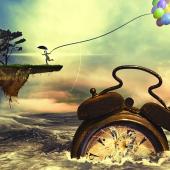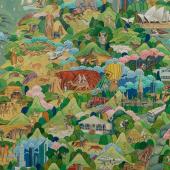Psychedelic Art
Psychedelic art is a style of contemporary art. Impressions from mind-altering drug experiences by example LSD, mescaline or psilocybin are used to create artworks in film, painting, music and literature. The origin of psychedelic art can be found in the 1960s, the beat generation and the hippie movement.
The stimulating and creative impact of psychedelic experiences of the young people at that time was reflected clearly in visual arts. Robert Masters and Jean Houston summarized the major characteristics of psychedelic art in 1968 as follows: "Accessibility to unconscious material, loosening the limits of the ego, liberation and flexibility of thought, intensified attention or increased concentration, resolution of perceptual constants, increased capacity for visual imagery and fantasies about specific symbolic and mythological natures, refinement of empathy, accelerating the speed of thinking, regressive ego functions, apparent recognition of the processes and organs within the body, recognizing deeper mental and spiritual levels of the ego, in some cases combined with the ability for deep religious and mystical experiences."
An outstanding artist of psychedelic painting is Alex Grey. The human being occupies centre stage in his paintings who he describes in physical, metaphysical and spiritual dimensions. In his artworks body panels, institutions as well as chakras and people´s auras are painted. Moreover, in his paintings often eyes recur as a classic symbol of the issuing psychedelic transcendence. His artworks are characterized by energy, which is reflected in love, birth or death.
However, the influences given to artists during psychedelic experiences always depend on complex interrelations in view of internal and external factors. And so today stunning artworks of psychedelic art ongoing emerge.



